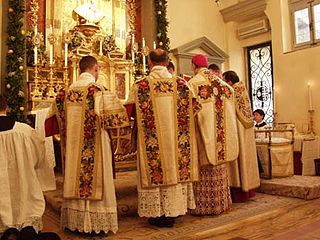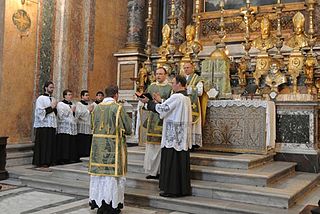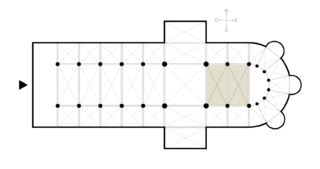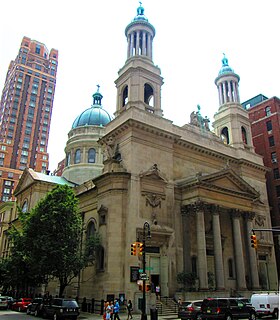Related Research Articles

An altar is a structure with an upper surface for the presentation of religious offerings, for sacrifices, or for other ritualistic purposes. Altars are found at shrines, temples, churches and other places of worship. They are used particularly in Paganism, Christianity, Buddhism, Hinduism, Judaism, and Modern Paganism. Many historical faiths also made use of them, including the Roman, Greek, and Norse religions.

The Tridentine Mass, also known as the Traditional Latin Mass or Traditional Rite, is the Roman Rite Mass of the Catholic Church which appears in typical editions of the Roman Missal published from 1570 to 1962. Celebrated exclusively in Ecclesiastical Latin, it was the most widely used Eucharistic liturgy in the world from its issuance in 1570 until the introduction of the Mass of Paul VI.

In the context of the Tridentine Mass of the Catholic Church, a Pontifical High Mass, also called Solemn Pontifical Mass, is a Solemn or High Mass celebrated by a bishop using certain prescribed ceremonies. The term is also used among Anglo-Catholic Anglicans. Although in modern English the word "pontifical" is almost exclusively associated with the Pope, any bishop may be properly called a pontiff. Thus, the celebrant of a Pontifical High Mass may be the pope or any bishop.
Low Mass is a Tridentine Mass defined officially in the Code of Rubrics included in the 1962 edition of the Roman Missal as a Mass in which the priest does not chant the parts that the rubrics assign to him. A sung Mass in turn is a ‘High’ or Solemn Mass if celebrated with the assistance of sacred ministers ; without them it is a Missa Cantata.

In church architecture, the chancel is the space around the altar, including the choir and the sanctuary, at the liturgical east end of a traditional Christian church building. It may terminate in an apse.

The rood screen is a common feature in late medieval church architecture. It is typically an ornate partition between the chancel and nave, of more or less open tracery constructed of wood, stone, or wrought iron. The rood screen would originally have been surmounted by a rood loft carrying the Great Rood, a sculptural representation of the Crucifixion. In English, Scottish, and Welsh cathedrals, monastic, and collegiate churches, there were commonly two transverse screens, with a rood screen or rood beam located one bay west of the pulpitum screen, but this double arrangement nowhere survives complete, and accordingly the preserved pulpitum in such churches is sometimes referred to as a rood screen. At Wells Cathedral the medieval arrangement was restored in the 20th century, with the medieval strainer arch supporting a rood, placed in front of the pulpitum and organ.

Choir dress is the traditional vesture of the clerics, seminarians and religious of Christian churches worn for public prayer and the administration of the sacraments except when celebrating or concelebrating the Eucharist. It differs from the vestments worn by the celebrants of the Eucharist, being normally made of fabrics such as wool, cotton or silk, as opposed to the fine brocades used in vestments. It may also be worn by lay assistants such as acolytes and choirs. It was abandoned by most of the Protestant churches that developed from the sixteenth-century Reformation.

A Latin Mass is a Roman Catholic Mass celebrated in Ecclesiastical Latin. While the liturgy is Latin, any sermon may be in the local vernacular, as permitted since the Council of Tours 813.

The Brompton Oratory is a large neo-classical Roman Catholic church in the Knightsbridge area of the Royal Borough of Kensington and Chelsea, London. Its full name is the Church of the Immaculate Heart of Mary, or as named in its Grade II* architectural listing, The Oratory. The church is closely connected with The London Oratory School, a school founded by the priests from the London Oratory. Its priests celebrate Mass daily in both the Ordinary and Extraordinary Form, frequently conduct ceremonies for well-known people, as it works as an extra-parochial church, and two of its three choirs have published physical copy and digital audio albums.

Solemn Mass is the full ceremonial form of the Tridentine Mass, celebrated by a priest with a deacon and a subdeacon, requiring most of the parts of the Mass to be sung, and the use of incense. It is also called High Mass or Solemn High Mass. However, in the United States the term "High Mass" is also used to describe the less elaborate Missa Cantata, which lacks deacon and subdeacon and some of the ceremonies connected with them.

A choir, also sometimes called quire, is the area of a church or cathedral that provides seating for the clergy and church choir. It is in the western part of the chancel, between the nave and the sanctuary, which houses the altar and Church tabernacle. In larger medieval churches it contained choir-stalls, seating aligned with the side of the church, so at right-angles to the seating for the congregation in the nave. Smaller medieval churches may not have a choir in the architectural sense at all, and they are often lacking in churches built by all denominations after the Protestant Reformation, though the Gothic Revival revived them as a distinct feature.
A Catholic order liturgical rite is a variant of a Catholic liturgical rite distinct from the typical ones, such as the Roman Rite, but instead specific to a certain Catholic religious order.

The Church of the Holy Family, also known as Holy Family Church and Katong Catholic Church, is a Roman Catholic church in the Archdiocese of Singapore. It is located at Chapel Road, off East Coast Road, and has one of the largest parish populations in the archdiocese.

The Mass is the central liturgical rite in the Catholic Church, encompassing the Liturgy of the Word and the Liturgy of the Eucharist, where the bread and wine are consecrated and become the Body and Blood of Christ. As defined by the Church at the Council of Trent, in the Mass, "the same Christ who offered himself once in a bloody manner on the altar of the cross, is present and offered in an unbloody manner". The Church describes the Mass as the "source and summit of the Christian life". It teaches that the sacramental bread and wine, through consecration by an ordained priest, become the sacrificial body, blood, soul, and divinity of Christ as the sacrifice on Calvary made truly present once again on the altar. The Catholic Church permits only baptised members in the state of grace to receive Christ in the Eucharist.
As currently used, the terms Chapter Mass and Conventual Mass refer to the Mass celebrated by and for a community of priests or for a community of priests and brothers or sisters.

Saint Pancras is an active Roman Catholic parish church serving the town centre of Ipswich, England. The neo-gothic church was built as part of the British Catholic revival in the nineteenth century, and was the target of anti-Catholic riots soon after completion.
The liturgical books of the Roman Rite are the official books containing the words to be recited and the actions to be performed in the celebration of Catholic liturgy as done in Rome. The Roman Rite of the Latin or Western Church of the Catholic Church is the most widely celebrated of the scores of Catholic liturgical rites. The titles of some of these books contain the adjective "Roman", e.g. the "Roman Missal", to distinguish them from the liturgical books for the other rites of the Church,.

St. Jean Baptiste Roman Catholic Church, also known as the Église St-Jean-Baptiste, is a parish church in the Roman Catholic Archdiocese of New York at the corner of Lexington Avenue and East 76th Street in the Lenox Hill neighborhood of the Upper East Side of Manhattan, New York City. The parish was established in 1882 to serve the area's French Canadian immigrant population and remained the French-Canadian National Parish until 1957. It has been staffed by the Fathers of the Blessed Sacrament since 1900.

Versus populum is the liturgical stance of a priest who, while celebrating Mass, faces the people from the other side of the altar. The opposite stance, that of a priest facing in the same direction as the people, is today called ad orientem or ad apsidem.

St. Francis de Sales Church is a Roman Catholic Oratory located in south St. Louis, Missouri, United States. It is the second largest church in the Archdiocese of St. Louis after the cathedral-basilica. The church is popularly known as the "Cathedral of South St. Louis."
References
- ↑ Herbermann, Charles, ed. (1913). . Catholic Encyclopedia . New York: Robert Appleton Company.